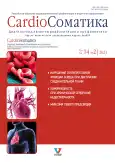Спонтанная диссекция передней коронарной межжелудочковой артерии у молодой женщины в поздний послеродовой период: клинический случай
- Авторы: Анохина А.Р.1,2, Матюшин Г.В.1,2, Устюгов С.А.1,2, Харьков Е.И.2,3, Савченко Е.А.2,3, Власов П.Н.1, Охримчук В.В.1, Скоробогатов В.В.1, Попова Е.В.1, Караев Э.Б.3, Цибульская Н.Ю.2,3, Рябков Е.И.3
-
Учреждения:
- Краевая клиническая больница
- Красноярский государственный медицинский университет им. проф. В.Ф. Войно-Ясенецкого
- Красноярская межрайонная клиническая больница скорой медицинской помощи им. Н.С. Карповича
- Выпуск: Том 14, № 2 (2023)
- Страницы: 115-122
- Раздел: Клинические случаи
- URL: https://journals.rcsi.science/2221-7185/article/view/146653
- DOI: https://doi.org/10.17816/CS409599
- ID: 146653
Цитировать
Полный текст
Аннотация
Обоснование. Сердечно-сосудистые осложнения во время беременности и в послеродовом периоде встречаются редко, но зачастую становятся фатальными. Одним из механизмов развития острого коронарного синдрома в послеродовом периоде является спонтанная диссекция коронарной артерии на фоне влияния половых гормонов. Ложный просвет интрамуральной гематомы перекрывает истинный, вызывая обструкцию артерии, приводя к острой гипоксии миокарда. Важно знать, что патофизиология спонтанной диссекции коронарной артерии отличается от острого коронарного синдрома на фоне разрыва атеросклеротической бляшки, что требует разного подхода к лечению таких пациентов.
Описание клинического случая. В статье описан сложный клинический случай развития острого инфаркта миокарда в послеродовом периоде у молодой девушки без факторов риска на фоне спонтанной диссекции коронарной артерии, осложнённого развитием кардиогенного шока, что потребовало экстренного чрескожного коронарного вмешательства, стентирования инфаркт-зависимой артерии, а также использования экстракорпоральной оксигенации.
Заключение. В настоящее время отсутствует однозначная и точная стратегия в отношении данной патологии, ввиду чего до сих пор возникают трудности ведения пациентов и выбора тактики лечения. По нашему мнению, должен быть обеспечен индивидуальный подход к каждому пациенту, принимая во внимание общее состояние организма, тип и объём диссекции, её последствия и осложнения, а также, несомненно, опыт и технические возможности клиники.
Полный текст
Открыть статью на сайте журналаОб авторах
Алена Руслановна Анохина
Краевая клиническая больница; Красноярский государственный медицинский университет им. проф. В.Ф. Войно-Ясенецкого
Автор, ответственный за переписку.
Email: alena.anohina.rus@yandex.ru
ORCID iD: 0000-0001-9528-762X
SPIN-код: 9055-9403
врач-кардиолог, ассистент кафедры
Россия, 660022, Красноярск, ул. Партизана Железняка, д. 3А; КрасноярскГеннадий Васильевич Матюшин
Краевая клиническая больница; Красноярский государственный медицинский университет им. проф. В.Ф. Войно-Ясенецкого
Email: matyushin1@yandex.ru
ORCID iD: 0000-0002-0150-6092
SPIN-код: 2398-1156
д.м.н., профессор, заведующий кафедрой
Россия, 660022, Красноярск, ул. Партизана Железняка, д. 3А; КрасноярскСергей Александрович Устюгов
Краевая клиническая больница; Красноярский государственный медицинский университет им. проф. В.Ф. Войно-Ясенецкого
Email: ustyugoff-s@yandex.ru
ORCID iD: 0000-0003-3105-1946
SPIN-код: 9045-7075
заведующий отделением, доцент кафедры
Россия, 660022, Красноярск, ул. Партизана Железняка, д. 3А; КрасноярскЕвгений Иванович Харьков
Красноярский государственный медицинский университет им. проф. В.Ф. Войно-Ясенецкого; Красноярская межрайонная клиническая больница скорой медицинской помощи им. Н.С. Карповича
Email: Harkov-50@mail.ru
ORCID iD: 0000-0002-8208-0926
SPIN-код: 1234-3885
д.м.н., профессор кафедры
Россия, Красноярск; КрасноярскЕлена Александровна Савченко
Красноярский государственный медицинский университет им. проф. В.Ф. Войно-Ясенецкого; Красноярская межрайонная клиническая больница скорой медицинской помощи им. Н.С. Карповича
Email: lenasavchenko@rambler.ru
ORCID iD: 0000-0003-4438-1434
SPIN-код: 2742-2621
к.м.н., доцент кафедры
Россия, Красноярск; КрасноярскПетр Николаевич Власов
Краевая клиническая больница
Email: v.petrn@mail.ru
ORCID iD: 0009-0002-3646-3165
врач анестезиолог-реаниматолог
Россия, 660022, Красноярск, ул. Партизана Железняка, д. 3АВадим Владимирович Охримчук
Краевая клиническая больница
Email: vadim_esenin@mail.ru
ORCID iD: 0000-0001-7714-1942
врач анестезиолог-реаниматолог
Россия, 660022, Красноярск, ул. Партизана Железняка, д. 3АВалентин Владимирович Скоробогатов
Краевая клиническая больница
Email: vaal_z@list.ru
ORCID iD: 0009-0002-6293-4098
врач-кардиолог
Россия, 660022, Красноярск, ул. Партизана Железняка, д. 3АЕкатерина Валерьевна Попова
Краевая клиническая больница
Email: veffy@mail.ru
ORCID iD: 0009-0004-8940-7612
врач-кардиолог
Россия, 660022, Красноярск, ул. Партизана Железняка, д. 3АЭлнур Байрам оглы Караев
Красноярская межрайонная клиническая больница скорой медицинской помощи им. Н.С. Карповича
Email: elnurmed@mail.ru
врач-кардиолог
Россия, КрасноярскНаталья Юрьевна Цибульская
Красноярский государственный медицинский университет им. проф. В.Ф. Войно-Ясенецкого; Красноярская межрайонная клиническая больница скорой медицинской помощи им. Н.С. Карповича
Email: solna33@yandex.ru
ORCID iD: 0000-0003-0122-0884
SPIN-код: 4238-8156
к.м.н., доцент кафедры
Россия, Красноярск; КрасноярскЕвгений Игоревич Рябков
Красноярская межрайонная клиническая больница скорой медицинской помощи им. Н.С. Карповича
Email: ryabkov.ei@mail.ru
врач рентген-хирург
Россия, КрасноярскСписок литературы
- Zhukova NS, Shakhnovich RM, Merkulova IN, et al. Spontaneous Coronary Artery Dissection. Kardiologiia. 2019;59(9):52–60. (In Russ). doi: 10.18087/cardio.2019.9.10269
- Hayes SN, Kim ESH, Saw J, et al. Spontaneous coronary artery dissection: current state of the science: a scientific statement from the American Heart Association. Circulation. 2018;137(19):e523–e557. doi: 10.1161/CIR.0000000000000564
- Protasova EA, Furman NV, Titkov IV, et al. Spontaneous coronary artery dissection as a cause of acute myocardial infarction. Cardiovascular Therapy and Prevention. 2014;13(5):70–73. (In Russ). doi: 10.15829/1728-8800-2014-5-70-73
- Vatutin NT, Taradin GG, Bort DV, et al. А cаsе of spontaneous coronary artery dissection (review and case report). The Russian Archives of Internal Medicine. 2019;9(1):23–30. (In Russ). doi: 10.20514/2226-6704-2019-9-1-23-30
- Alkhouli M, Cole M, Ling FS. Coronary artery fenestration prior to stenting in spontaneous coronary artery dissection. Catheter Cardiovasc Interv. 2016;88(1):E23–E27. doi: 10.1002/ccd.26161
- Kuznetsov AA, Namitokov AM, Sazhneva AV, et al. Spontaneous left coronary artery dissection in the postpartum period: a case report. Russian Journal of Cardiology. 2022;27(3S):5059. (In Russ). doi: 10.15829/1560-4071-2022-5059
- Bockeria LA, Golukhova EZ, Petrosyan KV, et al. Spontaneous coronary dissection: case reports and literature review. Creative Cardiology. 2020;14(1):71–81. (In Russ). doi: 10.24022/1997-3187-2020-14-1-71-81
- Alquran L, Patel A, Safi L, Patel A. A rare case of multivessel SCAD successfully treated with conservative medical management. Case Rep Cardiol. 2020;2020:8468730. doi: 10.1155/2020/8468730
Дополнительные файлы









